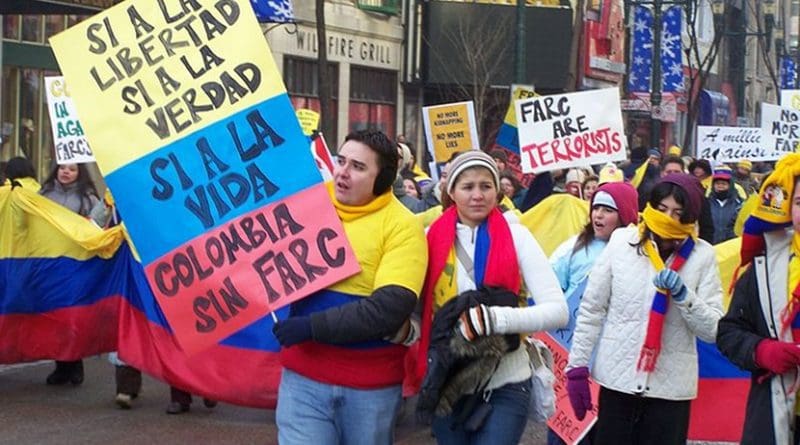Understanding The Colombian Peace Agreement Implementation: The Kroc Institute Report
It has been over a year since a peace agreement was signed between the Revolutionary Armed Forces of Colombia (FARC) and the Colombian government. What is the status report on its implementation? A newly released report from the Kroc Institute for International Peace Studies may provide the answer.
By Lina María Jaramillo*
A year after a peace agreement was signed between the Revolutionary Armed Forces of Colombia (FARC) and the Colombian government, the Kroc Institute for International Peace Studies at the University of Notre Dame released a special report highlighting the many advances, gaps and difficulties in the implementation process of one of the most comprehensive and innovative peace agreements in the history of peace processes around the world.[1]
Considering its vast experience in applying innovative methodologies – such as the Matrix Peace Accord Project (PAM) that applies a comparative analysis of peace processes around the world through the collection of quantitative and qualitative empirical data – [2] the FARC and the Colombian government have given the Kroc Institute a mandate to provide technical assistance, as well as to monitor and verify the implementation of the peace agreement.[3]
To monitor the implementation, the Kroc institute has identified 588 stipulations, clustered in 18 themes and 74 subthemes, contain all the compromises agreed by both parties across the six main chapters of the peace accord: land reform, political participation, the end of conflict, the problem of illicit drugs and its victims, truth and transitional justice, and the implementation and verification mechanisms of the peace agreement.
The research team established a coding scale between 0 and 3 to evaluate each stipulation in accordance with analysed and validated information gathered along this first year of implementation.
While a score of 0 means there has not been any progress in implementation, a score of 1 indicates that minimal actions have been implemented, a score of 2 means intermediate implementation on track to full implementation, and a score of 3 indicates that there has been full implementation of the stipulation.
The main conclusions of this report highlight the following:
- By the end of August, 251 stipulations in the peace agreement – some 45 per cent of its content – have been accompanied by implementation actions, while the remaining 307 stipulations – some 55 per cent – have not led to any implementation activities.
- 17 per cent of the stipulations have been fully implemented while 22 per cent of the stipulations have been implemented at a very low level.
- As far as short-term achievements, the report noted significant advances in matters such as disarmament, ceasefire, the implementation of verification mechanisms as well as some advances in normative regulations required to materialise several aspects of the peace agreements.
- The report made an urgent call to both parties to: prioritise immediate actions in order to overcome some difficulties in some aspects of the peace agreement, such as the implementation of security and protection guarantees for social leaders, human right defenders and former combatants at the territorial level; [4] accelerate the normative and law processes that would sustain fundamental instruments of the agreement like the Special Jurisdiction for Peace bill; [5] create mechanisms to energise the peace agreement’s chapter on land reform; enforce decrees that would improve political participation in isolated regions, and; apply normative instruments that establish differentiated criminal treatment for small crop farmers for the illicit use of their crops.
- The urgent implementation of a reintegration programme is mandatory along with all related instruments and mechanisms in order to ensure a real economic, political and social reintegration of all ex-combatants.
- Other aspects of political participation, electoral reform, as well as mechanisms to improve the inclusion and effective participation of women, indigenous communities and victims, are defined as medium-term measures that need to be tackled.
- There are also 246 stipulations that are considered long-term goals, and their achievement hinges on the effective implementation of short- and medium-term stipulations. With regards to these long-term goals, the report highlights certain concerns around issues such as land distribution, rural reform and the articulation of programmes for the substitution of illicit crops – all of which have shown little progress. Since these issues are directly related to the structural causes of conflict and violence in Colombia, it is imperative that the parties initiate some preventive measures to avoid a rise in violence and the establishment of new criminal organisations.
In a critical time where strong critics from various sectors around the peace process are reinforcing the polarised context in Colombia, the team at the Kroc Institute have made a call to the FARC, the government and Colombian civil society to maintain and strengthen the dialogue spaces that have been created in order to materialise all of their commitments in the peace agreement.
For more information, please refer to the full report (Spanish version) here: https://kroc.nd.edu/assets/257593/informe_kroc.pdf
*Lina María Jaramillo is Peace Insight’s Local Peacebuilding Expert for Colombia. Lina María is a political scientist with Master’s degrees in International Studies and International Development. For the past 8 years she has worked on projects related to peace, security and development issues and is currently with Oxfam as Knowledge Management Officer.
Footnotes
- Jessica Villamil Muños (23 November 2017), “’La paz no es hacer muchas cosas, sino construir legitimidad,’ Director Instituto Kroc,” El País Colombia
- For more information about the Peace Accords Matrix Project, click here.
- Renée LaReau (16 November 2017), “Colombian peace agreement progressing steadily, says Kroc Institute report,” Notre Dame News.
- The UN High Commission on Refugees (17 November 2017), “UNHCR concern at increasing murders of local leaders in Colombia,” UNHCR.
- RTT News (7 November 2017), “Colombia: UN urges Congress to approve Special Jurisdiction for peace,” Business Insider Inc.
This article was originally published by Insight on Conflict and is available by clicking here. The views expressed in this piece do not necessarily reflect those of TransConflict.

